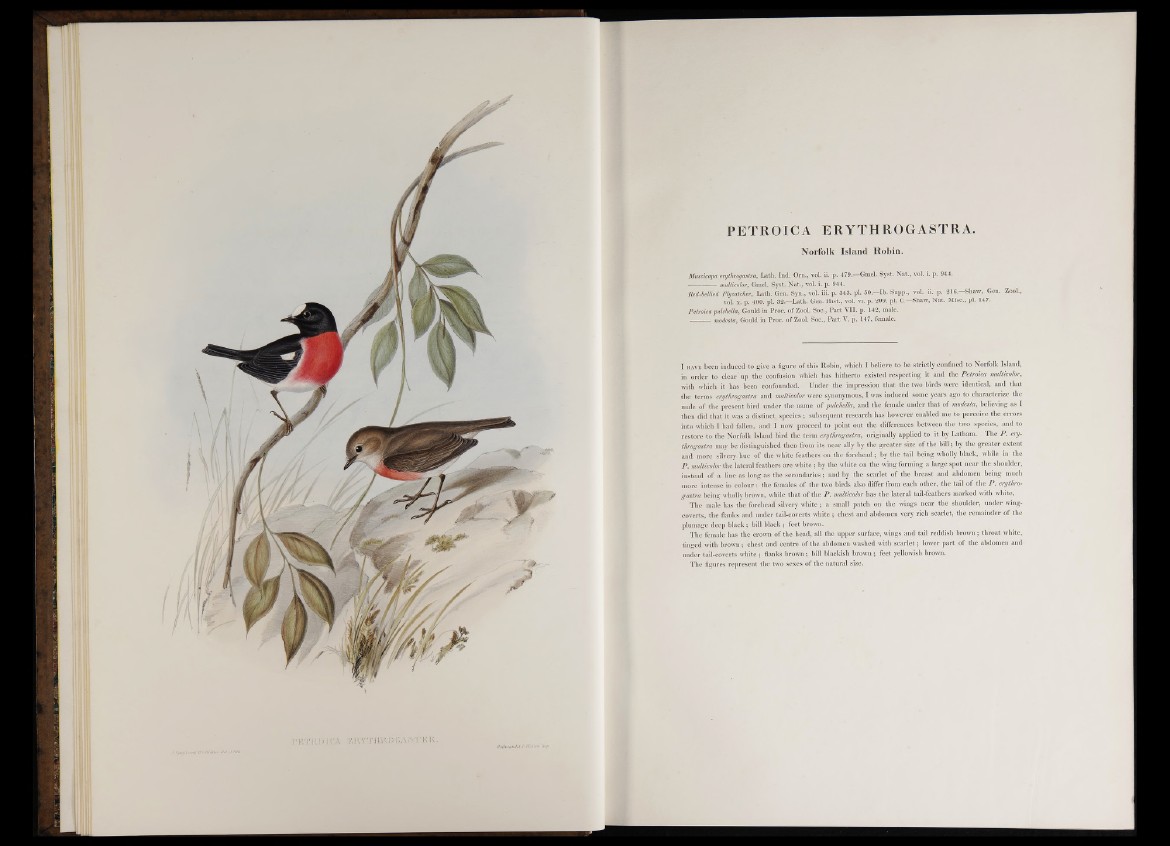
PETROICA ERYTHROGASTRA.
Norfolk Island Robin.
Muscicapa erythrogastra, Lath. Ind. Om., vol. ii. p. 479.—Gmel. Syst. Nat., vol. i. p. 944.
— multicolor, Gmel. Syst. Nat., vol. i. p. 944.
Red-heHiei Flycatcher, Laih. Gen. Syn., vol. iii. p. 343. pi. 50.—Ib. Snpp., vol. ii. p. 216—Shaw, Gen. Zool.,
*01: x. p. 400. pi. 32.—Lath. Gen. Hist., toL i t P- 209. pi. Q.—Shaw, Nat. Misc., pi. 147.
Petroica pulchella, Gould in Proc. of Zool. Soc., Part VII. p. 142, male.
modesta, Gould in Proc. of Zool. Soc., Part V. p. 147, female.
I h a v e been induced to give a figure o f this Robin, which I believe to be strictly confined to Norfolk Island,
in order to clear ’up the confusion which has hitherto existed respecting it and the Petroica multicolor,
with which it has been confounded. Under the impression that the two birds were identical, and that
the terms erythrogastra and multicolor were synonymous, I was induced some years ago to characterize the
male of the present bird under the name of pulchella, and the female under that o f modesta, believing as I
then did that it was a distinct, species ; subsequent research has however enabled me to perceive the errors
into which I had fallen, and I now proceed to point out the differences between the two species, and to
restore to the Norfolk Island bird the term erythrogastra, originally applied to it by Latham. The P . erythrogastra
may be distinguished then from its near ally by the greater size of the bill; by the greater extent
and more silvery, hue o f the white feathers on the forehead ; by the tail being wholly black, while in the
P . multicolor the lateral feathers are white ; by the white on the wing forming a large spot near the shoulder,
instead o f a line as long as the secondaries; and by the scarlet o f the breast and abdomen being much
more intense in colour: the females of the two birds also differ from each other, the tail of the P . erythrogastra
being wholly brown, while that of the P . multicolor has the lateral tail-feathers marked with white.
The male has the forehead silvery white; a small patch on the wings near the shoulder, under wing-
coverts, the flanks and under tail-coverts white; chest and abdomen very riel) scarlet, the remainder o f the
plumage deep black; bill black; feet brown.
The female has the crown o f the head, all the upper surface, wings and tail reddish brown; throat white,
tinned with brown; chest and centre o f the abdomen washed with scarlet; lower part o f the abdomen and
under tail-coverts white ; flanks brown ; bill blackish brown ; feet yellowish brown.
The figures represent the two sexes of the natural size.